As a new space race heats up, scientists have proposed for planetary geoarchaeology, the study of how cultural and natural processes on Earth’s moon, on Mars and across the solar system may be altering, preserving or destroying the material record of space exploration.
“Until recently, we might consider the material left behind during the space race of the mid-20th century as relatively safe,” said lead author Justin Holcomb, postdoctoral researcher at the Kansas Geological Survey, based at the University of Kansas.
“However, the material record that currently exists on the Moon is rapidly becoming at risk of being destroyed if proper attention isn’t paid during the new space era,” he added
Since the advent of space exploration, humans have launched more than 6,700 satellites and spacecraft from countries around the globe, according to the Union of Concerned Scientists.
The US alone accounts for more than 4,500 civil, commercial, governmental and military satellites.
“We’re trying to draw attention to the preservation, study and documentation of space heritage because I do think there’s a risk to this heritage on the moon,” Holcomb said.
“The US is trying to get boots on the Moon again, and China is as well. We’ve already had at least four countries accidentally crash into the moon recently. There are a lot of accidental crashes and not a lot of protection right now,” he said, in the paper published in the journal Geoarchaeology.
How planetary geoarchaeologists will determine whether an item is worth preserving is an open question.
“We have to make those decisions all the time with archaeological sites today,” Holcomb said.
With resources for protecting space heritage limited, Holcomb and his colleagues advocate for developing systems to track materials left in space.
“We should begin tracking our material record as it continues to expand, both to preserve the earliest record but also to keep a check on our impact on extraterrestrial environments,” he said. “It’s our job as anthropologists and archaeologists to bring issues of heritage to the forefront.”
Beyond the moon, Holcomb wants to see planetary geoarchaeology extend to issues related to exploration and migration to Mars. He points to NASA’s Spirit Rover as an example. The rover became stuck in Martian sand in 2008 and now risks being completely covered by encroaching sand dunes.
Holcomb believes geoarchaeologists should be included in future NASA missions to ensure the protection and safety of space heritage.


